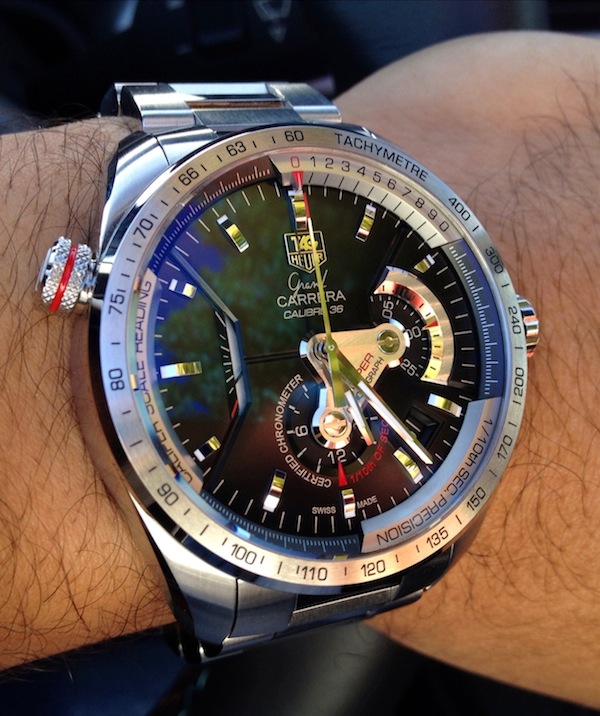
For a lot people, TAG Heuer’s many famous ambassadors are a positive attraction to the brand, however for others these celebrities are needless distractions. I have nothing against Leonardo DiCaprio nor Cameron Diaz, and the many other TAG ambassadors, but that’s not what attract me to the brand.
I have no clue if Mr. DiCaprio or Miss Diaz are horological aficionados, or if they are even knowledgeable about timepieces… So seeing their pictures on a TAG advertisement just makes me feel that the brand is simply banking heavily on the modern day infatuation with Hollywood stars to sell their watches.
What is hidden from this pageantry is the fact that TAG Heuer has a long history of innovation in the area of creating the finest chronographs. This glorious past of measuring time intervals at ever finer levels of precision has recently resurfaced at the past few BaselWorlds shows where TAG Heuer has introduced increasingly precise chronographs that measure 1/10, 1/100, 1/1000, and 5/10,000 (or 1/2000) of a second; yes, all with a mechanical movement!
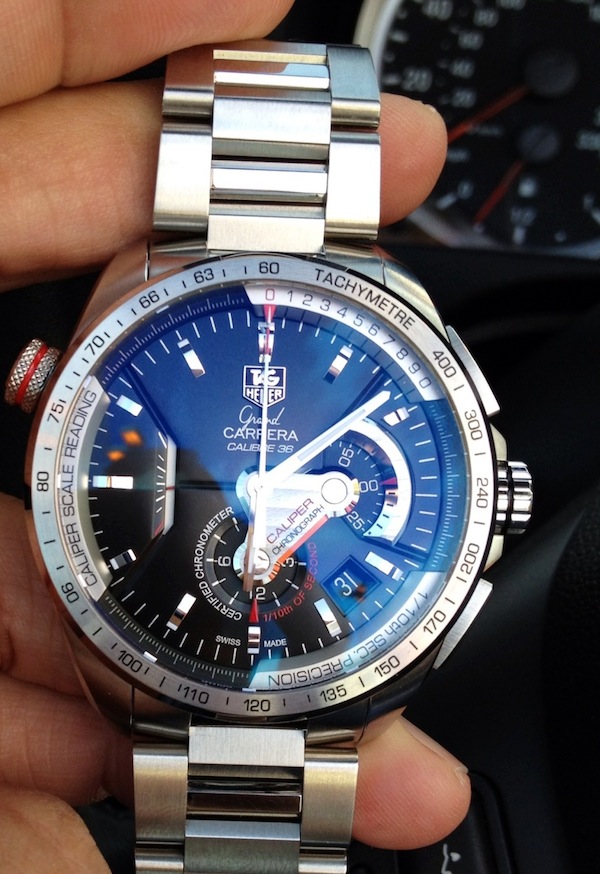
The latest version, the Mikrogirder, will likely see the light of day as a highly limited commercial edition like the Mikrograph and Mikrotimer before it, nonetheless, TAG’s recent dedication and R&D is boosting its brand and it is regaining its reputation in horological circles. One such early effort, and more affordable chronograph, is the Grand Carrera Caliber 36 RS Caliper Chronograph that can measure time to 1/10th of a second accuracy. Probably good enough for more people’s needs (and finger response times).
The TAG Heuer Grand Carrera Caliber 36 RS Caliper is an imposing watch. It is 43 mm wide and 15.75 mm high. At just over 190 grams, it is also rather heavy. Its steel construction reminds you that this is a manly instrument that can be used for serious timing tasks.
The main feature of the watch is the 1/10th of a second chronograph which comes from the TAG Heuer Caliber 36 movement. It is a modified version of the famous Zenith El Primero movement that runs at 36,000 bph – giving it the ability to measure these smaller intervals.
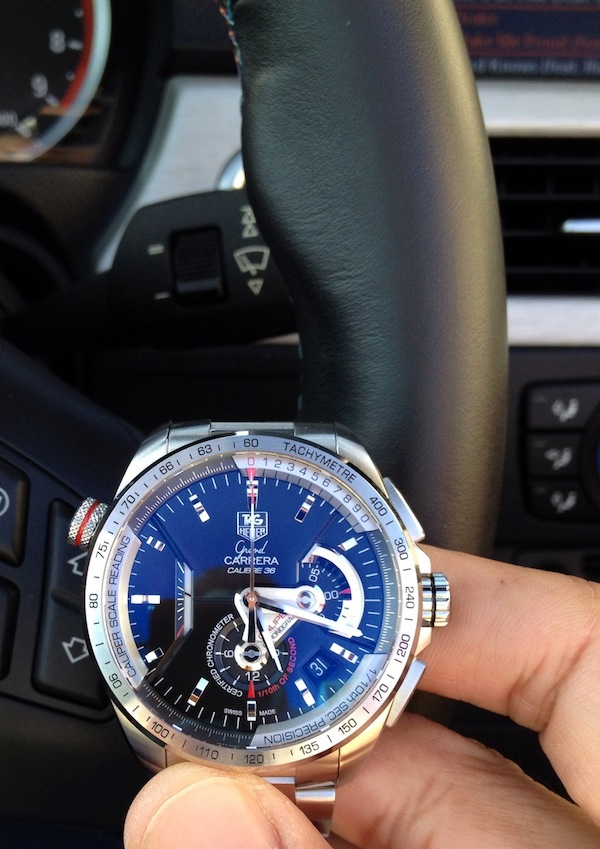
Like most two button chronographs, the TAG Heuer Grand Carrera Caliber 36 can be started with a push on the top button. The start button has a solid click feel to it.
The long, polished steel, seconds hand will move around the dial in micro-steps while the one-third quadrant at three o’clock tallies the minutes (up to 30) and three quarter quadrant at 6 o’clock tallies the hours (up to 12).
When engaged, a second push to the top button stops the chronograph. The second button resets the chronograph along with both the minutes and the hours tallies.
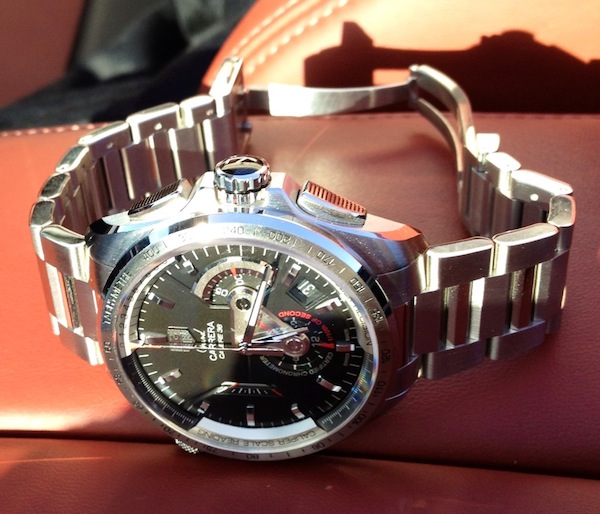
However, what sets this Grand Carrera apart is a simple, but wonderfully useful, and easy to use caliper that allows one to read the 1/10th second measurement right off the dial. Think of the caliper as a physical mechanical “magnifying glass” for the seconds markers.
It works as follows, once the chronograph is stopped, you move the caliper using the distinctive crown at 10 o’clock, which is adorned with a red stripe giving the watch an unbalanced yet instrumental feel. That crown moves the caliper back or forth around the dial like an internal bezel.
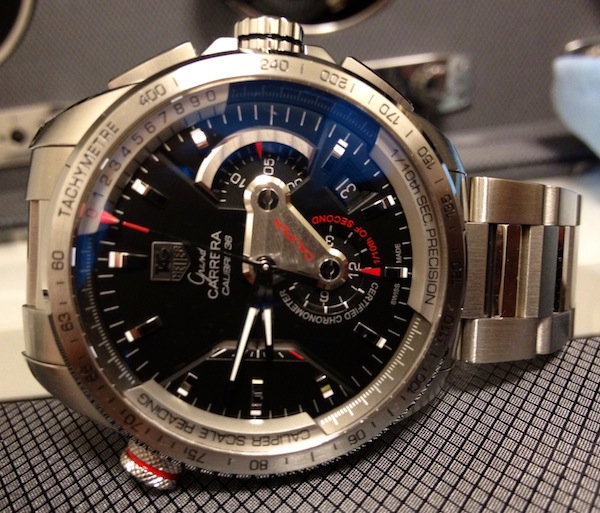
The caliper is simple, it has 11 digits, marked from 0 to 9 and then 0 again. The first 0 is red and has a special red marker. Using the 10 o’clock crown, one needs to align the caliper’s red marker with the location where the seconds hand stopped. From that point, the 1/10 seconds is indicated by finding the number on the caliper that best aligns with one of the next 10 seconds markers on the dial.
The whole thing works beautifully and precisely. It’s no wonder that TAG Heuer won first prize in the sports watch category for this innovation at the Grand Prix d’Horologerie de Geneve in 2008.
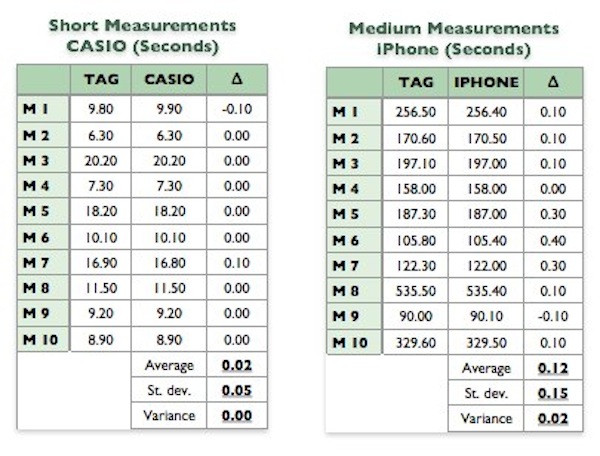
I made various short and long measurements during my Caltrain rides from San Jose to San Francisco (and intermediary stations) and back, using the Grand Carrera Caliber 36 along with my Casio Pathfinder and my iPhone 4S. The *non-scientific* results, shown in Tables 1 and 2, indicate that my TAG Heuer Grand Carrera Caliber 36 is not only accurate to 1/10th of a second, but it seems to deviate 0.05 seconds to the CASIO Pathfinder for short measurements and 0.15 second from my iPhone 4S clock application digital chronograph for longer measurements.
This is a decent result if you account for the fact that the margin of error of me pushing both the watch and the iPhone start buttons at the same time likely has a margin of error of at least +/- 0.05 second which is in the same order of magnitude as the measured deviations. As Ariel indicated to me, I also realize that there exist electronic machines that will precisely measure the accuracy of your chronograph, however, I don’t own one and am not about to invest in one either. Plus, while it took an hour or so of my time to tabulate and gather, it was fun to actually use the chronograph… How many can say that of your chronographs?
As I mentioned, the watch measures 43 millimeters with the well protected screwed down crown which is stamped with the TAG Heuer shield armor logo in silver on a black sapphire crystal. The watch’s dial is black with well visible hour markers in polished steel and marked seconds around the dial.
The dial is recessed and a second smaller dial where the caliper moves contains markers for 1/5th second between any two second markers. The bezel is also polished steel with a black marked tachymetre that is done discretely, thereby, not distracting the users who may not care to measure speed.
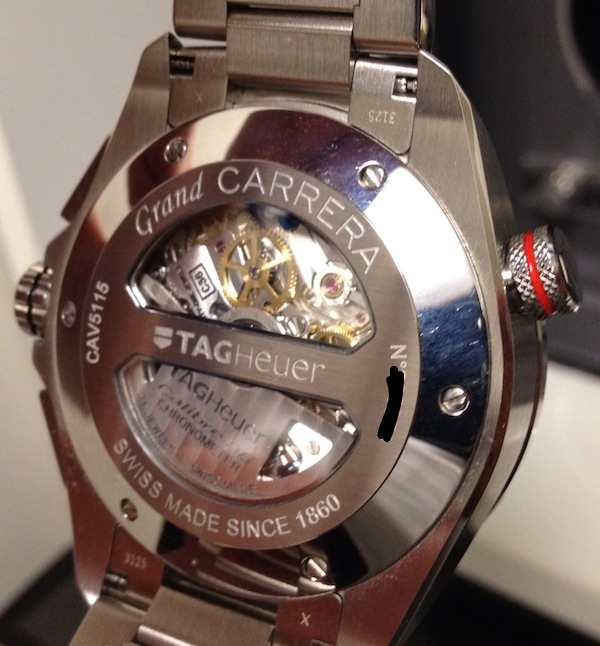
At 9 o’clock is a cutout vertical strip that allows the black and red hands to be seen and move to indicate the current seconds. While interesting and giving the dial an asymmetric feel, it is pretty useless and hard to read since there are no indications of what seconds we are at in a minute…
The black hand is shown for the first 40 seconds and the red for the last 20 seconds, thus helping the guessing game, but what I found is that it simply just frustrates me, as it is still too hard to guess what exact second it is at. The movement also does not hack so this cut has an always moving hand, I guess it tells you the watch is functioning.
The accuracy of the chronograph is in great part due to the El Primero-based movement which is a C.O.S.C. certified movement that beats at 36,000 bph. The beautiful movement can be seen from the sapphire window on the back.
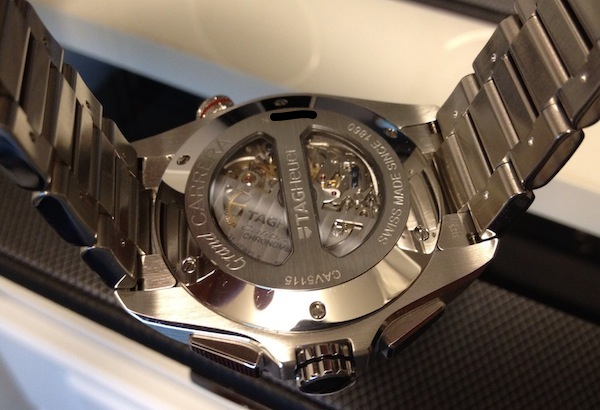
Unlike most visible casebacks, TAG decided to split this one into two viewing sapphire windows with the remaining steel marked with the TAG Heuer name and logo, model name and number, as well as the unique serial number of the watch.
The self-winding rotor is decorated with the TAG Heuer name and logo and cut open to better show the movement which is itself decorated with rubies, blue steel screws, and brass gears. The whole thing is quite impressive and accentuates the feel of a solid instrument.
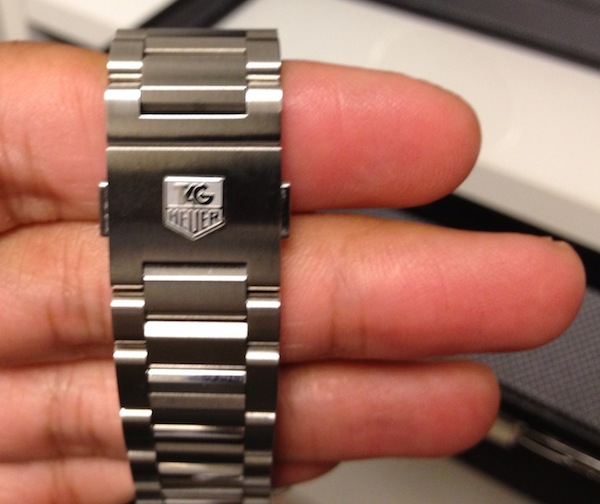
While the watch is heavy (0.43 lbs) and large, it actually wears small and seats comfortably on my 7.5 inch wrist. This is due to the steel bracelet whose lugs start of at 22 mm and narrow down at the deployment clasp that contains two small pushers making a satisfying click on open and on close. The small buckle has an engraved, flattened, TAG Heuer shield armor logo. It is small but easily visible thus allowing one to quickly see where to detach the strap.
The steel strap alternates with polished and brushed links that could not work better with the polished bezel and the hour markers. That combination gives the watch a slight shiny appearance that, while not ostentatious, makes it noticeable from far.
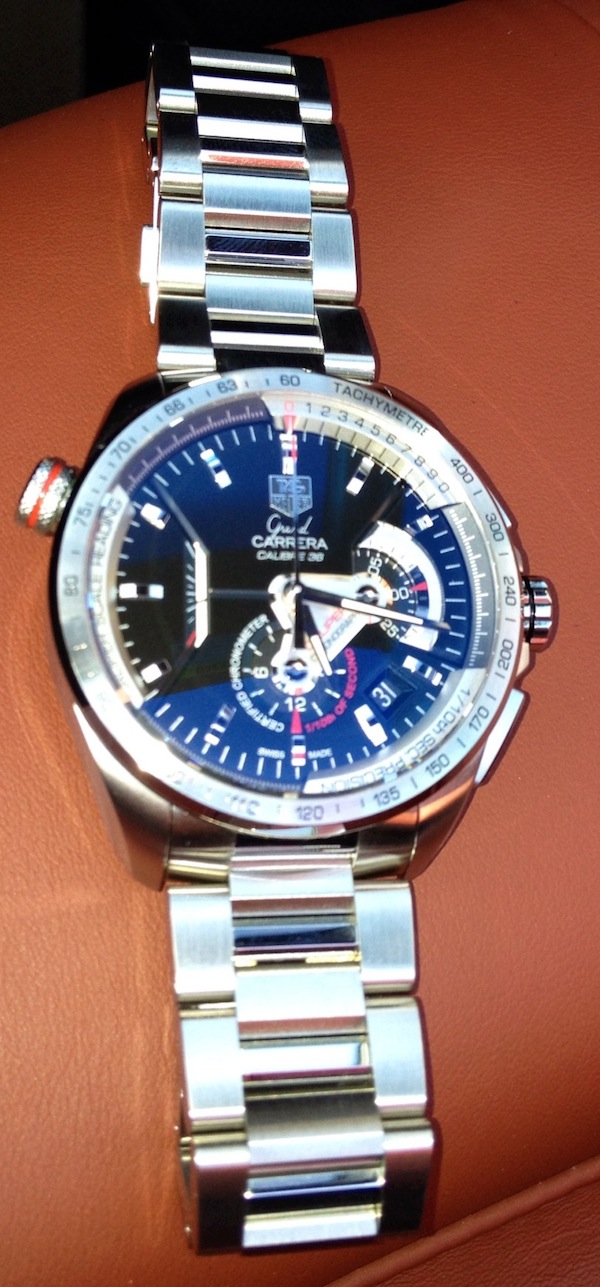
While this watch is easily the most accurate mechanical chronograph that I own and its speedy looks makes one want to be part of a race, it has a few minor negatives. Besides the useless seconds strip on the dial, this watch is not meant to be used at night.
The dial is simply not visible at night. There is a thin strip of Super-LumiNova application on the hours and on the minutes hands, but the hands are hardly viewable but for a few minutes after a charge.
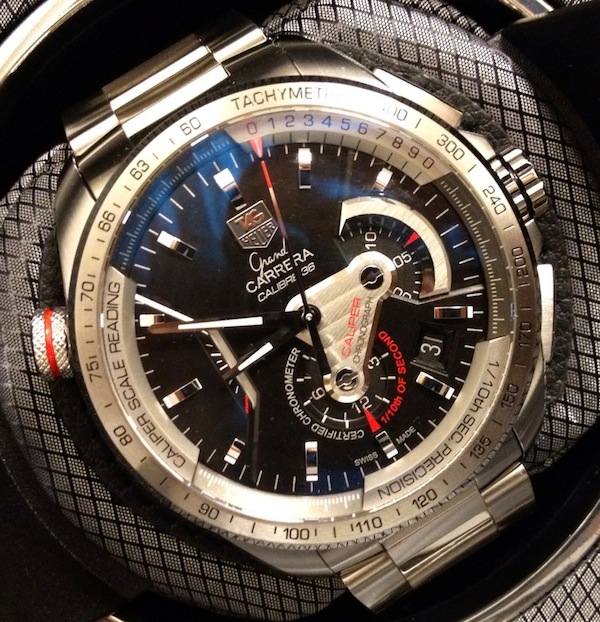
TAG Heuer makes four versions of the Grand Carrera Caliber 36 RS Caliper. The stainless steel version reference CAV5115.BA0902, reviewed here, sells for a manufacturer suggested price of $9,500, a steel with rubber band which is reference CAV5115.FT6019, and a black PVD titanium with black leather or black rubber strap which are references CAV5185.FC6237 and CAV5185.FT6020.
The black edition is slightly larger and has a higher price at $10,500, but not all are not limited editions, while they do have unique serial numbers. All the models are water resistant to 100 meters.
All models have small red accents on the dial to indicate the caliper marker, the minutes and hours tally, as well the caliper crown. Overall I am quite satisfied with the TAG Heuer Grand Carrera Caliber 36 RS Caliper Chronograph. It’s a super accurate chronograph and the innovative (even though it borrows from a very classic concept) 1/10th of a second caliper readout works brilliantly and adds to the overall look and feel of speed and racing that this model and the TAG Heuer brand stand for.
Necessary Data
>Brand: TAG Heuer
>Model: Grand Carrera Caliber 36 RS Caliper reference CAV5115.BA0902
>Price: $9,500
>Would reviewer personally wear it: Yes
>Friend we’d recommend it to first: To the 20-something to 30-something guy with a passion for sports cars and a timepiece budget of $7k to $10k.
>Worst characteristic of watch: Minimal lume on the hands and no lume on the dial means that this watch is practically unusable at night.
>Best characteristic of watch: Fit on my wrist (I have a 7 and 1/4 inch wrist) and the clever and innovative caliper system that makes reading the 1/10th seconds reading of the excellent TAG Caliber 36 chronograph movement a breeze.
